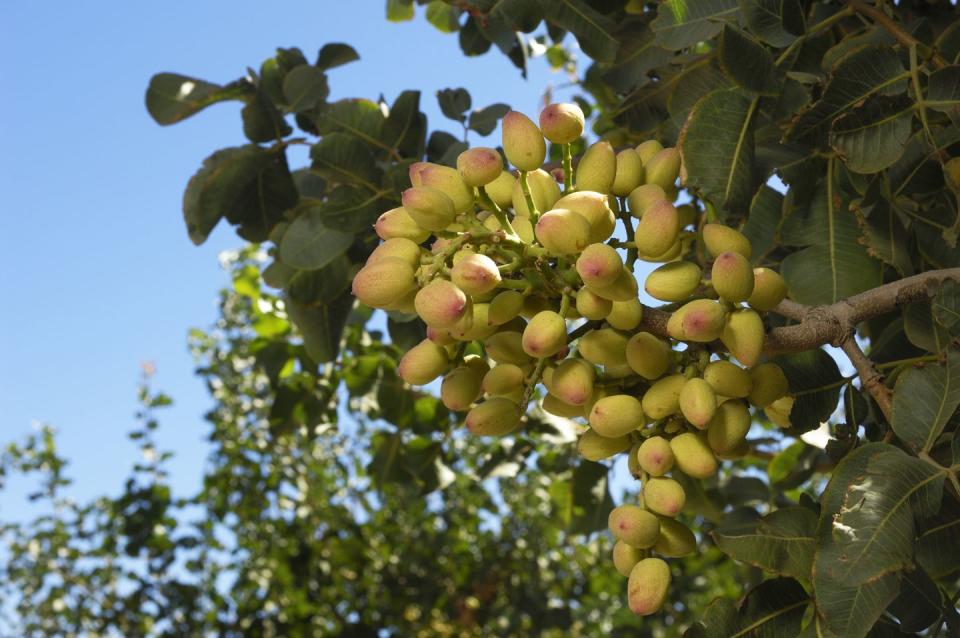Pistachios Have Tons of Health Benefits, According to Nutritionists

When it comes to nuts, pistachios are often overlooked—even though they are tiny nutritional goldmines. “These little morsels are rich in fiber, heart-healthy fats, and are a good source of satiating protein,” says Maya Feller, M.S., R.D., C.D.N., founder of Maya Feller Nutrition and author of The Southern Comfort Food Diabetes Cookbook: Over 100 Recipes for a Healthy Life. Keep reading to find out exactly how these yummy nuts can benefit your health.
1. Pistachios are packed with nutrients.
“Pistachios are nutrition powerhouses loaded with antioxidants that help to minimize free radical and combat oxidative stress in the body,” says Feller. “They also contain an incredible amount of vitamin B6, whose properties support healthy brain development and immune and nervous system functions.” But that’s not all. “A pistachio is a pretty cool nut,” says Becci Twombley, R.D., C.S.S.D., a sports dietitian for the Los Angeles Angels and Lakers as well as a partner with American Pistachios. “It has every essential nutrient, except for vitamin C. Pistachios are high in omega-three fatty acids and they have three different types of antioxidants. They also have protein, healthy fats, good carbohydrates, fiber, and vitamin A. The amount of nutrition that's contained in just one pistachio is really impressive.”
2. The protein in pistachios is key.
It’s helpful to know that one serving of pistachios is 1 ounce or 28 grams or about 49 nuts. That might sound like a lot, but they’re pretty small without their shells. “Pistachios offer 6 grams of plant-based protein per serving and help fuel your body with essential amino acids,” says Feller. “As one of the highest-protein snack nuts, pistachios are an excellent addition to a well-balanced pattern of eating.” This means they can be especially helpful for vegetarians or people trying to cut back on the protein they get from animal sources.
3. Fiber gives pistachios superpowers.
“Pistachios are rich in fiber, which research shows encourages stable blood glucose levels and digestive regularity,” says Feller. One serving contains 3 grams of fiber. “The nuts act as a prebiotic and provide nutrients for good bacteria located in the gut microbiome, which is essential for gut and overall health,” adds Feller. Plus, high-fiber foods help you feel full so you’re less likely to reach for less nutritious foods.
4. Pistachios are a boon for your heart.
“Studies show that including pistachios in your everyday nutrition plan can be beneficial to cardiovascular health and decrease associated disease risk factors,” says Feller. “Nearly 90% of the fats found in pistachios fall under the better-for-you mono- and polyunsaturated types, which have been shown to have positive effects on LDL (“bad”) cholesterol and in fact decrease their levels.” On top of that, Twombley notes that research shows pistachios can support blood flow and blood pressure. “We use them in the bullpen—when Angels players get up to start warming up, they eat an ounce to try to improve blood flow as they go into the game,” she says. “It improves their oxygenation and gives them a little better endurance during that time, but also helps with recovery afterwards, to try to help save their arms.”
5. Pistachios may also lower inflammation.
It all comes down the high polyphenol content of the nuts. “Inflammation is the cause of just about every disease,” explains Twombley. “A lot of the time inflammation—especially in heart disease—is measured by the amount of something called interleukin six in your blood, and there's a direct relationship between polyphenol intake to lower that heart risk.”

6. Raw pistachios are minimally processed.
Good news if you're trying to cut down on the processed foods that you eat: "Pistachios are probably one of the most minimally processed foods that exist,” says Twombley. “Nature cracks them open on the tree and then they have this really cool machine that just goes on the base of the tree with a big net/shield kind of a thing and then shakes the tree and all the kernels fall down into the container. It gets sent to a drying facility and then roasting. That's it. No human hands touch it during the processing.”
How to pick packaged pistachios:
You’ll find an array of pistachios on store shelves, and they’re all pretty tasty. “They can be enjoyed raw, roasted, shelled, or flavored,” says Feller. She loves ones that are spiced with chili lime, tamari, or cumin and black pepper. “I do check the sodium to make sure that it's on the lower end so under 5% of the daily value for sodium,” adds Feller. “If you have the time, purchasing raw pistachios and roasting/flavoring them at home can aid in monitoring sodium intake as well.” You'll also want to steer clear of honey-roasted options if you're watching your sugar intake.
How to add pistachios to your diet:
While perfectly tasty on their own, these nuts are surprisingly versatile. Try some of these strategies for incorporating pistachios into your meal plan.
Use as a topper for rice, salads, or desserts, suggests Feller.
Mix into granola or smoothies.
Crush and add to your favorite energy ball recipe.
Blend into a nut butter.
“We incorporate them a lot into our breading for meats,” says Twombley. “Even something like chicken can become a lot more nutrient dense if when you bread it you incorporate crushed pistachios in there.”
Support from readers like you helps us do our best work. Go here to subscribe to Prevention and get 12 FREE gifts. And sign up for our FREE newsletter here for daily health, nutrition, and fitness advice.
You Might Also Like

